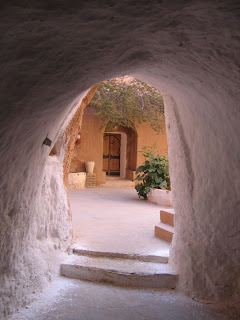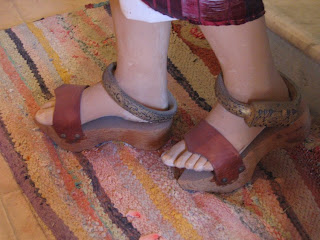It's been over a month since we got back from Tunisia and I still haven't posted the rest of the photos I promised. So here they are. Click each photo if you want a better view.
Accommodation - As mentioned James and I stayed in locally owned accommodations which all had their own personalities. Here are my top 6 favourites:
Accommodation - As mentioned James and I stayed in locally owned accommodations which all had their own personalities. Here are my top 6 favourites:
 This is a room in a funduq. Funduqs were a common feature of medieval Islamic cities, and are usually composed of at least two floors of rooms arranged around a central courtyard. They provided traveling merchants with accommodation and storage space for goods and animals. This funduq was located in Houmt Souq on the island of Djerba.
This is a room in a funduq. Funduqs were a common feature of medieval Islamic cities, and are usually composed of at least two floors of rooms arranged around a central courtyard. They provided traveling merchants with accommodation and storage space for goods and animals. This funduq was located in Houmt Souq on the island of Djerba. A troglodyte dwelling is essentially a cave. To survive the intense summer temperatures of Southern Tunisia, the Berber learnt to create dwellings under the earth where they were able to stay cool. I'm prone to claustrophobia and was a little freaked out at the idea of sleeping underground, but the troglodytes were really well designed and cozy and I actually enjoyed the experience.
A troglodyte dwelling is essentially a cave. To survive the intense summer temperatures of Southern Tunisia, the Berber learnt to create dwellings under the earth where they were able to stay cool. I'm prone to claustrophobia and was a little freaked out at the idea of sleeping underground, but the troglodytes were really well designed and cozy and I actually enjoyed the experience.
 We stayed in the hotel built under this boardwalk in the seaside town of Monastir. Every room looked out over the Mediterranean ocean.
We stayed in the hotel built under this boardwalk in the seaside town of Monastir. Every room looked out over the Mediterranean ocean. We returned to Monastir on our way back to Tunis and stayed in another hotel where our windows and balcony looked out over the marina.
We returned to Monastir on our way back to Tunis and stayed in another hotel where our windows and balcony looked out over the marina. These were our beds in the Bedouin tent in the oasis of Ksar Guilane in the Sahara. The tent was amazingly well insulated which was a good thing because the temperature at night felt more like the South Pole than the Sahara. I wish I'd taken a picture of the outside.
These were our beds in the Bedouin tent in the oasis of Ksar Guilane in the Sahara. The tent was amazingly well insulated which was a good thing because the temperature at night felt more like the South Pole than the Sahara. I wish I'd taken a picture of the outside.Ruins
Tunisia is filled with the vestiges of the various civilizations that invaded, colonised and mingled with the indigenous Berber population over 2 mellenia.
The Phoenicians (modern day Lebanese), the Romans, the Ottomans (one area of modern day Turkey), the Byzantines (another area of modern day Turkey), the Arabs, and last of all the French have all left they mark on Tunisia.
As mentioned before the Arabs are responsible for much of the wonderful architecture to be found throughout Tunisia, such as this monument to the first President of independent Tunisia, Habib Bourguiba.
The Phoenicians (modern day Lebanese), the Romans, the Ottomans (one area of modern day Turkey), the Byzantines (another area of modern day Turkey), the Arabs, and last of all the French have all left they mark on Tunisia.
As mentioned before the Arabs are responsible for much of the wonderful architecture to be found throughout Tunisia, such as this monument to the first President of independent Tunisia, Habib Bourguiba.

and the French built all the Nouvelle Villes like this one already shown.

Of all the ancient civilisations it is the Romans that have left the most indelible mark on Tunisia. The Northern part of Tunisia is littered with Roman ruins. Just driving along we would stumble upon disembodied columns or arches like this one below. 
Here is a sampling of some of the Roman ruins we visited:
The town of Bulla Regia
An arch in the town of Haidra

Coliseum El Gem


 The tunnel Gladiators walked through on their way to meet their deaths. Gives new meaning to the saying 'I can see the light at then end of the tunnel'.
The tunnel Gladiators walked through on their way to meet their deaths. Gives new meaning to the saying 'I can see the light at then end of the tunnel'.Dougga
 Romans created amazing mosaics to adorn their floors. Many of these can still be seen at the various ruins but most now reside in the Bardo Museum in Tunis which is considered to contain the best Roman mosaics in the world.
Romans created amazing mosaics to adorn their floors. Many of these can still be seen at the various ruins but most now reside in the Bardo Museum in Tunis which is considered to contain the best Roman mosaics in the world.Carthage
 All that is left of the ancient Phoenician city of Carthage which reached it's height in the 9th century BC before it was invaded and destroyed by Rome which in turn built a new Carthage on it's ruins.
All that is left of the ancient Phoenician city of Carthage which reached it's height in the 9th century BC before it was invaded and destroyed by Rome which in turn built a new Carthage on it's ruins. Part of a mosaic which tells the story of Ulysses. Here Ulysses is bound to the mass of his ship so he cannot respond to the call of the sirens.
Part of a mosaic which tells the story of Ulysses. Here Ulysses is bound to the mass of his ship so he cannot respond to the call of the sirens. These two columns to be found in the Great Mosque of Kairouan were recycled from one of the many roman ruins around the country.
These two columns to be found in the Great Mosque of Kairouan were recycled from one of the many roman ruins around the country.Culture/Miscellaneous
Just a collection of random things I found interesting:
 One of the most beautiful things I have ever heard in my life was the sound of the Koran being spoken melodically (sounds like singing but technically it is not) from this mosque. We were walking back to our hotel after dinner one night when the Muezzin (the person who issues the call for prayer) began and it stopped us dead in our tracks. It was so incredibly soulful and beautiful that even though I didn't understand the words, I understand the meaning in such an intensely visceral way that it made me weep.
One of the most beautiful things I have ever heard in my life was the sound of the Koran being spoken melodically (sounds like singing but technically it is not) from this mosque. We were walking back to our hotel after dinner one night when the Muezzin (the person who issues the call for prayer) began and it stopped us dead in our tracks. It was so incredibly soulful and beautiful that even though I didn't understand the words, I understand the meaning in such an intensely visceral way that it made me weep. Okay I know how to read it and what it means, but how do I say it?
Okay I know how to read it and what it means, but how do I say it? These dried chili peppers are used to make harissa, a red hot paste which is used as a condiment and/or as an ingredient in Tunisian cuisine.
These dried chili peppers are used to make harissa, a red hot paste which is used as a condiment and/or as an ingredient in Tunisian cuisine. I could do a whole photo essay on the benches of the world. It is incredible how much variety can be found in such a simple functional public object.
I could do a whole photo essay on the benches of the world. It is incredible how much variety can be found in such a simple functional public object. Now who knew that cork grows on trees? I didn't. Actually, I never though about it until we visited this cork forest. The cork has been removed from most of the bark of this cork oak tree, leaving some cork bark only towards the top. Apparently, a cork oak must be at least 25 years old before its bark can be harvested. Its cork can then be stripped every 8 to 14 years after that for as long as the tree lives.
Now who knew that cork grows on trees? I didn't. Actually, I never though about it until we visited this cork forest. The cork has been removed from most of the bark of this cork oak tree, leaving some cork bark only towards the top. Apparently, a cork oak must be at least 25 years old before its bark can be harvested. Its cork can then be stripped every 8 to 14 years after that for as long as the tree lives. Traditional Berber ankle bracelets and wooden shoes shown on a mannequin. I guess they're designed to keep women from running away.
Traditional Berber ankle bracelets and wooden shoes shown on a mannequin. I guess they're designed to keep women from running away. Almost every town has some sort of sculpture at it's entrance and exit. I though this one was really lovely.
Almost every town has some sort of sculpture at it's entrance and exit. I though this one was really lovely. Tunisia has an amazing system of well kept roads. But the drivers are insane. Here is an example of the kind of craziness that needs to be monitored by someone.
Tunisia has an amazing system of well kept roads. But the drivers are insane. Here is an example of the kind of craziness that needs to be monitored by someone. Craftsman working patiently to embed silver in this carpet comb.
Craftsman working patiently to embed silver in this carpet comb. The Great Mosque of Kairouan is the oldest Muslim place of prayer in North Africa and is commonly regarded as the fourth holiest site in IslamafterMecca, Medina and Jerusalem.
The Great Mosque of Kairouan is the oldest Muslim place of prayer in North Africa and is commonly regarded as the fourth holiest site in IslamafterMecca, Medina and Jerusalem. This Bedouin instrument sounds a little like a bagpipe. It is made from gazelle skin and various horns.
This Bedouin instrument sounds a little like a bagpipe. It is made from gazelle skin and various horns. Public transport taking the Bedouine to the oasis town of Douz 100 kilometers away.
Public transport taking the Bedouine to the oasis town of Douz 100 kilometers away. Would also be interesting to do a series of photos on the various animals one is warned to look out for on the highways from one country to the next.
Would also be interesting to do a series of photos on the various animals one is warned to look out for on the highways from one country to the next.




















What an amazing trip! Your photos are truly beautiful. Perhaps those ankle bracelets are workout gear? They look quite heavy.
ReplyDeleteI'm so envious!
ReplyDeleteI think the troglodyte and the Bedouin tent might compete for coolest sleeping arrangements!
Lovely,interesting photos, thanks for sharing them. I loved the bagpipes, can't imagine "Scotland the Brave" coming out of those ones!
ReplyDeleteAmazing photos of wonderful people and places. You are truly blessed to have seen them in person!! Thanks for sharing the photos, I enjoyed them.
ReplyDelete